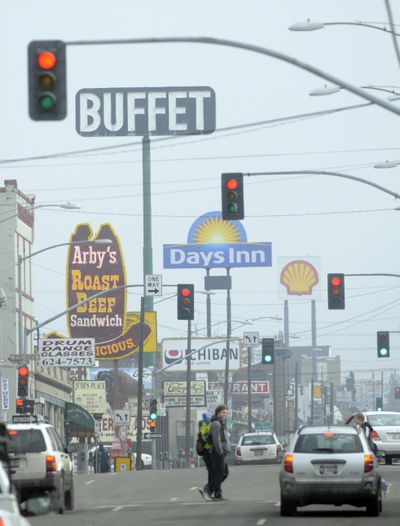New rules would alter sign skyline in Spokane

Everything from the height of golden arches along the freeway to the size of a cardboard placard advertising a garage sale would be subject to new regulations under an expansive proposed sign law that will be debated tonight by the Spokane City Council.
The city’s main sign ordinance was approved in 1958 and has been updated numerous times. The proposed 45-page replacement has been in the works since 2006, said Ken Pelton, a city senior planner.
“We don’t set out to fill up pages with ink on any of our codes, but this one is complex,” said Spokane Mayor Mary Verner. “It does involve constitutional free speech rights. We needed to make sure it was thorough, that it was legally defensible.”
Among the changes:
•Changing-image signs, such as the new digital sign advertising upcoming shows in front of the INB Performing Arts Center, or bank signs that update the time and temperature, would be outlawed.
•Signs along Division Street and Third Avenue that currently don’t face height regulations would be limited to 25 feet. Existing signs above the limit would be grandfathered unless they were updated. In other zones, sign height limits would be lowered from 35 feet to 20 or from 20 feet to 15.
•It would be illegal to post more than three signs advertising a garage sale, not including the sign in front of the home. Rules also say that garage sale signs could be no larger than four square feet. Similar regulations affect signs announcing an open house for a property for sale.
•Rules regarding sign zones would shift. In some zones larger signs would be allowed, depending on a business’s frontage. In other areas, new signs would have to be smaller.
•Fines for violating sign rules would increase from $125 to $250.
“It’s the right thing for public safety and for the aesthetics of our city,” said David Tanner, owner of L&L Architectural Sign Inc. and a member of a task force that helped with the creation of the rules. “The city’s signage will take on a different appearance that is not quite as in-your-face.”
But John Johnston, sales manager for Spokane Valley-based Sign Corp., called the rules “an incredible departure from the status quo.”
He said the rules would severely hurt businesses’ ability – and their rights – to communicate with customers. He added that changing-image signs can be designed tastefully and that businesses have invested tens of thousands of dollars to install them.
“If they didn’t work, they wouldn’t (spend) that,” Johnston said.
In endorsing the regulations, the City Plan Commission cited traffic studies from 1951, 1961, 1963, 1976 and 1978 that indicate that signs distract motorists.
Tanner said changing-image signs are especially problematic.
“It’s no different than if you allowed the front cockpit of a car to have a DVD player,” he said.
Johnston questions the use of studies more than three decades old, especially in relation to high-quality digital signs that weren’t even in existence.
The Plan Commission’s vote was a close 5-4 split, caused largely over controversy about changing-image signs.
“You can regulate and create standards for signage, but you cannot just ban signs because some people don’t like them or approve of them,” said a letter to City Council signed by Plan Commission members who opposed the plan.
Pelton said the length of the proposal doesn’t mean the rules are more burdensome.
“It provides a lot more detail and there’s a lot of use of tables and graphs that add to the length but improves the readability and understanding of it,” he said.